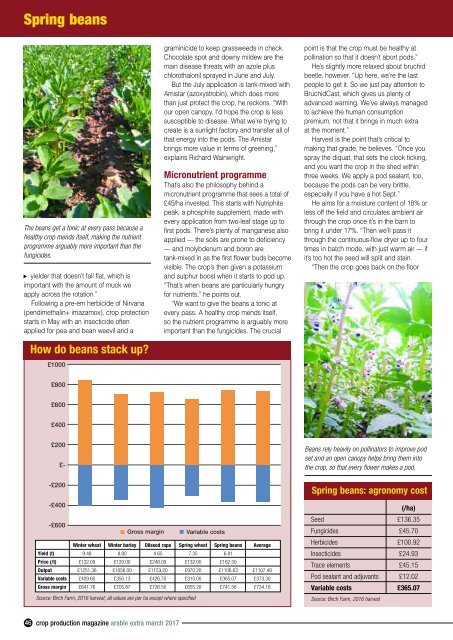In this issue..
CPM-March-Extra-2017
CPM-March-Extra-2017
Create successful ePaper yourself
Turn your PDF publications into a flip-book with our unique Google optimized e-Paper software.
Spring beans<br />
The beans get a tonic at every pass because a<br />
healthy crop mends itself, making the nutrient<br />
programme arguably more important than the<br />
fungicides.<br />
yielder that doesn’t fall flat, which is<br />
important with the amount of muck we<br />
apply across the rotation.”<br />
Following a pre-em herbicide of Nirvana<br />
(pendimethalin+ imazamox), crop protection<br />
starts in May with an insecticide often<br />
applied for pea and bean weevil and a<br />
▲<br />
How do beans stack up?<br />
£1000<br />
graminicide to keep grassweeds in check.<br />
Chocolate spot and downy mildew are the<br />
main disease threats with an azole plus<br />
chlorothalonil sprayed in June and July.<br />
But the July application is tank-mixed with<br />
Amistar (azoxystrobin), which does more<br />
than just protect the crop, he reckons. “With<br />
our open canopy, I’d hope the crop is less<br />
susceptible to disease. What we’re trying to<br />
create is a sunlight factory and transfer all of<br />
that energy into the pods. The Amistar<br />
brings more value in terms of greening,”<br />
explains Richard Wainwright.<br />
Micronutrient programme<br />
That’s also the philosophy behind a<br />
micronutrient programme that sees a total of<br />
£45/ha invested. This starts with Nutriphite<br />
peak, a phosphite supplement, made with<br />
every application from two-leaf stage up to<br />
first pods. There’s plenty of manganese also<br />
applied –– the soils are prone to deficiency<br />
–– and molybdenum and boron are<br />
tank-mixed in as the first flower buds become<br />
visible. The crop’s then given a potassium<br />
and sulphur boost when it starts to pod up.<br />
“That’s when beans are particularly hungry<br />
for nutrients,” he points out.<br />
“We want to give the beans a tonic at<br />
every pass. A healthy crop mends itself,<br />
so the nutrient programme is arguably more<br />
important than the fungicides. The crucial<br />
point is that the crop must be healthy at<br />
pollination so that it doesn’t abort pods.”<br />
He’s slightly more relaxed about bruchid<br />
beetle, however. “Up here, we’re the last<br />
people to get it. So we just pay attention to<br />
BruchidCast, which gives us plenty of<br />
advanced warning. We’ve always managed<br />
to achieve the human consumption<br />
premium, not that it brings in much extra<br />
at the moment.”<br />
Harvest is the point that’s critical to<br />
making that grade, he believes. “Once you<br />
spray the diquat, that sets the clock ticking,<br />
and you want the crop in the shed within<br />
three weeks. We apply a pod sealant, too,<br />
because the pods can be very brittle,<br />
especially if you have a hot Sept.”<br />
He aims for a moisture content of 18% or<br />
less off the field and circulates ambient air<br />
through the crop once it’s in the barn to<br />
bring it under 17%. “Then we’ll pass it<br />
through the continuous-flow dryer up to four<br />
times in batch mode, with just warm air –– if<br />
it’s too hot the seed will split and stain.<br />
“Then the crop goes back on the floor<br />
£800<br />
£600<br />
£400<br />
£200<br />
£-<br />
Beans rely heavily on pollinators to improve pod<br />
set and an open canopy helps bring them into<br />
the crop, so that every flower makes a pod.<br />
-£200<br />
-£400<br />
-£600<br />
Gross margin Variable costs<br />
Winter wheat Winter barley Oilseed rape Spring wheat Spring beans Average<br />
Yield (t) 9.48 8.80 4.65 7.35 6.81<br />
Price (/t) £132.00 £120.00 £248.00 £132.00 £162.50<br />
Output £1251.36 £1056.00 £1153.20 £970.20 £1106.63 £1107.48<br />
Variable costs £409.60 £350.13 £426.70 £315.00 £365.07 £373.30<br />
Gross margin £841.76 £705.87 £726.50 £655.20 £741.56 £734.18<br />
Source: Birch Farm, 2016 harvest; all values are per ha except where specified<br />
Spring beans: agronomy cost<br />
(/ha)<br />
Seed £136.35<br />
Fungicides £45.70<br />
Herbicides £100.92<br />
<strong>In</strong>secticides £24.93<br />
Trace elements £45.15<br />
Pod sealant and adjuvants £12.02<br />
Variable costs £365.07<br />
Source: Birch Farm, 2016 harvest<br />
46 crop production magazine arable extra march 2017


